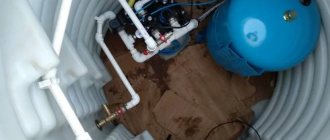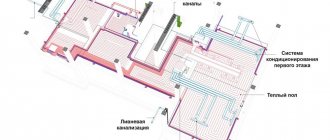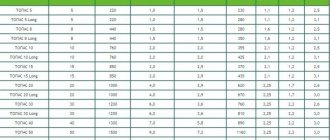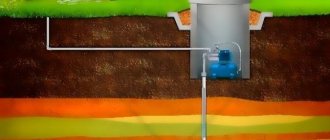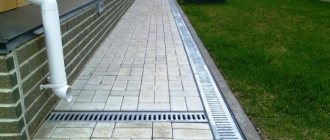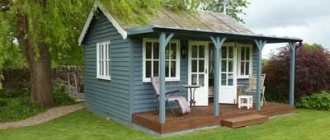A septic tank for a private home that does not require pumping is presented on the Russian market with standard, reinforced structures for permanent residence and temporary use. The product rating includes the most inconspicuous designs - complete absence of odor, minimal maintenance, small area of products, resistance to groundwater. Models for temporary use are inexpensive, can be installed and maintained independently. Devices intended for permanent residence are more demanding in terms of operating conditions - it is important to ensure the recommended minimum of wastewater and a stable supply of electricity.
Checklist for beginners
It is impossible to decide on the type of waste disposal device until you describe in detail the conditions of its operation that exist on the site. A member of our portal with the nickname sonder RZN has compiled a checklist for those who are choosing and considering a sewerage scheme in a private house. It doesn’t matter whether you do it yourself or with the help of specialists: these questions still need to be answered.
- Determine the type of soil on the site. This can be done at home - just roll the soil into a sausage.
Geolog197FORUMHOUSE Member
If, with a length of 1 cm, the thickness is more than 3 mm, then it falls apart, then it is sandy loam; 1-3 mm is loam, less is clay. If the sausage doesn't roll, it's sand.
It is also necessary to do a test for water absorption: dig a hole 0.5 X 0.5 m, 1 meter deep, pour water into it, note the time and measure the speed at which it leaves. An estimate like “all the water was gone in three hours” is enough. If this is not enough, you can independently calculate the filtration coefficient using a simplified scheme available to every summer resident.
- Determine the level of groundwater and flood waters in the area, understand what the level of high water is.
- Draw up a site plan. It is important that this design indicates neighboring properties and adjacent roads.
- Determine the topography of the site and the topography of the surrounding area. Mark on the plan all ravines, rivers, lakes, ponds. The size of the plot is also important. Without all this, it is impossible to find the best place to install a sewerage system. A filtration field with outlet pipes is a potentially dangerous object; it can be placed no closer than 30 meters from a source of drinking water and no closer than five meters from the foundation of a house.
- Determine the planned volume of wastewater. Often, owners of country premises simply take 200 liters per person per day. You can refer to the document “Water Consumption Standards for Consumers. Water consumption standards. SNiP 2.04.01-85 Internal water supply and sewerage of buildings." When making calculations, you need to take into account how many people live in the house, and when and how many people periodically come to stay - the volume of the volley discharge (short-term entry into the sewer system of wastewater, during which the concentration of pollutants sharply increases) depends on this; Peak load on the sewer system.
The value of a salvo discharge depends on how many plumbing fixtures are in use at the same time. If the volume of wastewater is calculated incorrectly, there is a risk of overflowing treatment facilities.
- Calculate and write down which plumbing fixtures will be in the house on each floor and how many.
- Be sure to take into account where the sewage system is being installed: in a country house or in a house for year-round use.
- A very important factor is the stability of electricity. It’s one thing if it works without interruption or is turned off no more than once every three months for an hour, and another if it’s turned off for half a day every week. This is important for new generation treatment facilities, the design of which includes pumps, sensors, aerators, compressors, etc., which operate from the electrical network.
- Is it possible to service the device yourself?
- To understand whether a sewage truck can drive to the house and to the treatment plant, and to choose its location correctly.
- Consider how far the house is from the city or town.
Rating of domestic offers
The production of treatment facilities for local sewage systems on the Russian market began only a few decades ago. But over the years, many manufacturers have emerged specializing in this area.
The models of some of them are only copies of leading European brands, but still the majority are truly unique structures and structures.
Today on the market you can find models with different operational parameters, starting with primitive mini-septic tanks and ending with complex multi-stage treatment stations
Based on the results of a survey of consumers who actively use wastewater purifiers on their property, we have compiled a rating of septic tanks:
- Eurobion. The stations are the result of many years of work by specialists from the Yubas production association. Thanks to the use of innovative membrane technology and a rhythmic aeration tank, the stations can be operated even during long periods of downtime of the sewer system.
- Poplar. The products are famous for their high degree of purification, reaching 99%. By using a non-standard design in production, in which access to the primary chamber is open, the manufacturer has simplified the maintenance of the sections: large debris that impedes the operation of the sewer system can be removed from them independently.
- Aster. Septic tanks-settlers of the Unilos brand guarantee the removal of harmful components up to 75%. There are several modifications on sale depending on the number of consumers. The station, supplemented by a compressor, performs cleaning in several stages, due to which the wastewater that passes through it is permitted by sanitary standards to be discharged into a ditch.
- Tank. Products manufactured by . The model range includes compact tanks with a capacity of 600 l/day, and high-performance structures designed for 1200 l/day. Their parameters are identical to classic treatment plants with multi-stage wastewater treatment.
- Triton. Another popular product from this company. The model range of septic tanks of this brand includes several types, differing in configuration and cleaning method. Products of the “micro” and “mini” classes are designed for volumes of 450 and 750 liters, and storage tanks of the type with the letter designation “H” and “T” are designed for volumes of 10 thousand liters and above.
- Tver. The products of the trading house "Engineering Equipment" carry out wastewater treatment not only mechanically, but also biologically. The stations are equipped with a four-level wastewater clarification system and are designed to process waste from 750 to 1.5 thousand cubic meters per day.
- Topas. Products manufactured under this brand are characterized by low energy consumption. Four-chamber aerobic devices have a cleaning rate of up to 98%.
A distinctive feature of the products produced is the large thickness of the walls and the presence of stiffening ribs, thanks to which they can easily withstand large external loads.
They also do not float up even under the influence of floods, if their presence was not taken into account when choosing the design.
Almost all factory-made septic tank models offer the possibility of connecting additional modules to increase the capacity of the treatment plant
The treatment facilities of the Leader production enterprise are also no less popular. Polypropylene tanks of this brand carry out three stages of cleaning: mechanical, aerobic and biofiltration.
Rostok septic tanks produced by Rostok have also proven themselves well. The manufacturer specializes in the production of anaerobic treatment devices.
But, since the percentage of cleaning inside the chambers reaches only 65-70%, for the full operation of the structures it is necessary to install drainage tunnels.
The presence of designs with various parameters in the model lines of the listed manufacturers allows any consumer to make a rational choice, based on the optimal price/quality ratio.
Septic tank or aeration unit - how to choose
After checking the site according to the checklist, you can begin to select a device that is suitable for a particular site. In the table, they are all conditionally divided into three groups:
- concrete septic tanks;
- plastic septic tanks;
- aeration installations.
Vadim (spb) FORUMHOUSE Moderator
Depends on many things - on the soil, groundwater level, living conditions, availability of electricity, volume of water consumption, budget. Some people prefer a septic tank, others prefer an AU.
Features, disadvantages and advantages of the installations are collected in a table.
Do-it-yourself sewerage in a private house: choosing a device
| Concrete septic tank | Plastic septic tank | AU |
| No electricity required | No electricity required | Electricity required |
| At high groundwater levels, it is difficult to seal. | The body is sealed; anchoring and often reinforcement are required. | Sealed housing, no anchoring required. |
| It copes well with uneven runoff and can be used in “weekend” mode. | It copes well with uneven runoff and can be used in “weekend” mode. | Used for permanent residence, it copes poorly with uneven drainage. |
| Copes perfectly with “volley discharge”. | Copes perfectly with “volley discharge”. | “Valley release” holds only under special conditions. |
| Pumping with a sewer truck should be performed up to 3 times a year. | Pumping with a sewer truck should be performed up to 3 times a year. | It is necessary to pump out the sludge with a mud pump. |
| Does not require special maintenance. | Does not require special maintenance. | Almost all devices of this type require special servicing every six months or every three months. |
| You can do it yourself. | You can do it yourself if you have certain skills and knowledge. | You can’t do it yourself without special equipment. |
| In most cases, this is the most budget option. | Medium budget option. | The most expensive option. |
| Can be connected to filter wells, sand and gravel filters and filter trenches, infiltrators, drainage blocks, drainage tunnels. | Connection to filter wells, sand and gravel filters and filter trenches, infiltrators, drainage blocks, drainage tunnels is allowed. | Can be connected to filter wells, sand and gravel filters and filter trenches, infiltrators, drainage blocks, drainage tunnels and storm ditches. |
If a sewer outlet has already been made from the foundation of the house, you will also have to take into account the depth of the sewer pipe.
This list of devices does not include cesspools, although relatively recently they were a widespread, budget-friendly way to properly arrange sewerage in a private house with a bathroom and toilet. It was believed that if the sewerage system for a country house was made independently, then it was a cesspool, a container for collecting wastewater that flowed through the external sewerage pipeline. These effluents were not treated, but simply pumped out as needed.
This outdated solution is still used today. The walls of the cesspool are lined with brick or concrete; sometimes the cesspool is made without a bottom, and such a structure cannot be called safe.
PavelForumHouse Member
All this is cheap and cheerful until the SES arrives. You can make good money and poison your neighbors. Are your plots expensive? Does it make sense to get rid of neighbors?
A homeowner who has decided on a cesspool needs to know the requirements of SNiP 30-02-97 and SanPiN 42-128-4690-88, according to which:
- You cannot make a hole without a bottom if more than 1 cubic meter is drained into it. If more than two people live in the house and plumbing equipment is installed, a pit without a bottom is also prohibited;
- You cannot make a cesspool closer than 15 meters from the house without approval from Rospotrebnadzor and the Vodokanal Administration.
- The distance of the cesspool from the water supply depends on the material of the pipeline. If the pipes are plastic, then it should be at least 1.5 m; made of cast iron - more than 1.5 m; for asbestos-cement pipes - at least five meters.
- The depth of the cesspool is no more than 3 meters, and the groundwater level must also be taken into account.
If the groundwater level is high, you cannot make a cesspool.
- It is forbidden to fill the container more than 35 cm from the top, this can lead to overflow and contamination of the soil and aquifers!
The cesspool must be cleaned frequently; it is quite expensive and the entire budget comes down to zero.
Now the participants of our portal, if they make sewers with cesspools in private houses with their own hands, it is only in summer cottages and for “clean drainage”: after a shower or a sink for washing dishes. Although it is easy to make such a sewer system for a private house with your own hands, it cannot be considered successful.
Conclusion
With correct calculations and adherence to the scheme, the efficiency of wastewater treatment in home-made devices is not inferior to factory designs. But the feasibility of independent construction depends on the groundwater level. With a low groundwater level, it is cheaper to make a septic tank with your own hands, and with a high groundwater level, it is better to buy a ready-made sealed product.
The participants of our portal and experts in the topic “How to understand which sewer system to make?” will help you make the final choice. The topic about autonomous sewerage systems includes information on regulatory documentation, treatment plans for different groundwater occurrences and useful videos. Our other topics will help you install an aerobic septic tank and figure out whether bacteria can be added to the septic tank. This article about collective wastewater treatment systems talks about the advantages and disadvantages of sewage systems “for three”. The video contains recommendations from a specialist on choosing sewer pipes.
Subscribe to our Telegram channelExclusive posts every week
Criteria for selecting a filter device
Now you can proceed to choosing a filter device. Without this, it is impossible to properly install a sewer system for a private home.
For modern domestic installations, in most cases the following are used:
FC (filtration well). It is done only on sand and sandy loam - soils that absorb moisture well - SNiP 2.04.03-85 “Sewerage” insists on this. External networks and structures.” The amount of wastewater should not be more than a cubic meter per knock, and the base of the well must be placed at a distance of at least a meter from the water main water supply.
Sand and gravel filters and filter trenches. Suitable if the amount of wastewater is no more than 15 cubic meters per day, they are made in waterproof and low-filtration soils (rock, clay and loam. The highest level of groundwater level is a meter below the drainage tray.
Infiltrators, drainage blocks, drainage tunnels can be made in any type of soil, and the blocks can be connected to each other.
Which septic tank is suitable for the site: plastic or reinforced concrete
A modern sewer system in a private house will look correct if it is based on a septic tank. This option is chosen by the vast majority of homeowners.
In septic tanks, mechanical wastewater treatment occurs due to sedimentation, and only then due to the fact that bacteria living in the septic tank destroy organic matter in the absence of air. After settling and mechanically purified in septic tanks, the wastewater is sent either to filter devices.
LadomirModerator FORUMHOUSE
It is forbidden to pour effluent from a septic tank into a ditch; it is punishable and unhygienic.
The septic tank must have a bottom and be sealed. The construction of septic tanks is regulated by the standard for organizing autonomous sewage systems with septic tanks and soil underground filtration of wastewater - STO NOSTROY 2.17.176-2015. This document provides for the following distances of the septic tank from other objects on the site:
- to the house – 5 meters;
- to a well or borehole in areas with clayey soil or loam - 20 meters in areas with clayey soil;
- to a well or borehole in areas with loam, sandy loam or sand - 50-80 meters;
- to the side of the road – 5 meters;
- to the border of the site - 4 meters;
- to trees - 3 meters;
- to the bush - 1 meter;
- to a river or stream – 10 meters;
- to a pond or lake – 30 meters;
- to the underground gas main - 5 meters.
In the table, all septic tanks are divided into plastic and septic tanks made of concrete rings. For do-it-yourself sewerage in a private house, septic tanks made of reinforced concrete rings . They are the most budget-friendly, they are durable, almost eternal, can withstand heavy loads under soil pressure and are easy to install yourself. But such septic tanks are unacceptable when there is high water and high groundwater level.
Plastic septic tanks can also be installed in areas with high groundwater levels; they are lightweight, but many plastic structures are fragile, can be deformed during frost heaving of the soil and require anchoring. When buying a plastic septic tank, it is recommended to look at the internal partitions and stiffeners along the body - the more of them, the higher the rigidity of the product. Horizontal plastic septic tanks clean wastewater better, but vertical ones are more compact.
Like a cesspool, a septic tank must be periodically cleaned with a sewer truck, but if you choose the right volume, this will have to be done no more than once a year.
Calculating the volume of a septic tank is quite simple: it should be three times the daily volume of drainage. This also follows from the main book of all home engineers, “Engineering Systems of a Country House,” authored by V. Sinelnikov.
The constantly filled part of the well (hydraulic volume) should be equal to three times the daily inflow.
Vadim (spb) FORUMHOUSE Moderator
3 cubes is enough for 4 people. And it doesn’t matter, in my opinion, how the filtering is organized. The volume of the septic tank does not depend on it.
LadomirModerator FORUMHOUSE
According to the Standard, the volume of the septic tank must be at least 2.4 cubic meters, even if 0.5 people live irregularly.
Construction of a septic tank made of concrete rings
When the State Water Inspectorate allows, the majority of forum members prefer concrete rings, from which two sealed chambers and a filtration well are usually assembled, connected to each other by overflow pipes. To get the most impermeable structure possible, choose rings with a groove connection; they are not only more resistant to possible ground movements, but it is also easier to achieve the tightness of such a seam. External and internal waterproofing is used with bitumen primers or solutions based on CPS with the addition of liquid glass. There are two options for the arrangement of cameras - sequential and combined.
In the first, settling tanks are placed one after another, and the FCs are placed at a short distance, each with its own neck and inspection cap. The optimal design for a septic tank of this type was developed in one of the forum topics by a participant with the nickname MatrasMSA with the help of moderator Ladomir.
MatrasMSAUser FORUMHOUSE
The plot is 40x60 meters with a slope, a bathhouse/guest house is currently being built, three people live on weekend visits and sometimes guests, in the future there will be a house for permanent residence. The groundwater level is low, it is problematic to get to the water, the well is 88 meters deep, according to neighbors, the soil is loam. I am planning a septic tank like this: the first and second wells are three rings each (1.5 m in diameter) with a concrete bottom, the third well is the same, but the bottom is on the ground.
During the discussion, the following typical recommendations for the device were given.
Ladomir
- A straight tee is placed on the pipe entering the septic tank, the lower part is buried 15-30 cm into the drains, similarly on the outlet pipe.
- The outlet from the septic tank is 5-10 cm lower than the entrance to it, measured along the lower pipe tray.
- The overflow between the chambers is done at a depth of 0.4 m from the height of the drain column in the septic tank.
- The height of the drains into the septic tank is the distance from the bottom to the bottom tray of the pipe coming out of the septic tank.
- The branch pipe entering the filter well does not need to be equipped with a tee; it is routed in such a way that the wastewater flows into the center of the FC.
- Under the filter well, gravel/crushed stone is added, 0.3-0.5 m thick, and sprinkled on the sides, in a layer of up to 0.2 m.
Taking into account all the adjustments and recommendations, a septic tank diagram appeared: an almost finished preliminary design of a two-chamber device with a filter well made of reinforced concrete rings.
The combined septic tank (designed by A. Egoryshev) is compact due to the arrangement of sedimentation tanks and FC in a triangle and is suitable for small areas. All wells are closed with blind covers, in which inspection holes are cut out, a common neck (service well) is installed on top, and the fan riser is discharged through the cover of the service well. To prevent differences between settling tanks, a concrete slab with a hole for the FC is poured at the bottom of the pit, a drainage pad (filter cassette) made of ASG, 10 cm thick, is poured under the slab, on a double layer of geotextile.
On our portal, this scheme was proposed by a craftsman with the nickname s_e_s_h, who posted the design and a similar construction process in his topic back in 2009, “alive” to this day, which proves the relevance of systems of a similar operating principle.
s_e_s_hUser FORUMHOUSE
The requirements for the septic tank, taking into account the standards and needs of the family, were as follows:
- Good treatment of domestic wastewater at the outlet of the septic tank.
- A volume sufficient for permanent residence in a house of 3-4 people (bath, shower, 3 sinks, washing machine and dishwasher, 2 toilets).
- Winter operation.
- Reliable design with the ability to easily maintain the septic tank itself and underwater communications.
- Neat and discreet final appearance.
- Minimum possible cash costs.
The result was an economical design without sacrificing functionality.
However, both options are suitable only for areas with a low groundwater level; with a high groundwater level, no matter how you isolate the wells, there is a danger of them being flooded with high water and polluting the area with wastewater.
Aeration plant in a suburban area
The sewerage system in a private house with an aeration plant (the term VOC is also used, local treatment plant) is considered the most modern for wastewater disposal, the quality of treatment reaches 90%.
These installations in the sewerage system are complex and cannot be done with your own hands. They are based on devices made of fiberglass or propylene, but due to their design with stiffening ribs and many protruding elements, they are not deformed and are not squeezed out to the surface by heaving soils.
ACs operate on a different principle than septic tanks. If in septic tanks wastewater is first mechanically purified during settling, and organic matter is partially decomposed during anaerobic processes, then in AC the main purification occurs during the oxidation of organic molecules with oxygen. In such a sewerage system in a private house, bacteria work, which require oxygen to live (in sewerage systems with septic tanks, this process takes place in filtration wells, filtration fields, etc.).
There are two types of AC – with a compressor or a drain pump. In an AC with a compressor, wastewater, after settling in the first chamber, enters the second, and there it is saturated with oxygen. What happens is that the microflora in the wastewater multiplies wildly and forms activated sludge, which destroys all organic compounds. The water becomes clearer, but now it contains silt particles. All this goes into the third chamber, the sludge settles and is sent back to the aerochamber, and the purified water is removed outside the installation.
In an AC with a drainage pump there are also several chambers, and wastewater moves between them by gravity. The treated wastewater is pumped to the sprayer, then passes through the biofilter, cleaned and discharged outside.
For stable operation of aeration units, electricity is required, and even a shutdown for several hours is fraught with the death of aerobic bacteria. The second disadvantage of AU is its blatant lack of budget; any septic tank always costs less.
The AC on the site should be located below the well or borehole, but so that in the spring it will not be flooded with melt water. Like septic tanks, VOCs are installed in a pit with a sand lining at the bottom.
Many manufacturers allow water to be discharged from the AC directly onto the terrain, into a ravine, forest, or storm drain. This is still a controversial issue, and many are inclined to believe that this should not be done, or only after additional and expensive disinfection; but it is recommended to install AU in areas with clayey and heaving soil, high groundwater level and where there is no possibility of making a filtration well, filtration field and other filtration installations.
Principle of operation
The operating principle of a septic tank, equipped according to all the rules, is a complex scheme, as a result of which the negative impact on the soil and the environment is minimized. According to the traditional scheme, a septic tank is a treatment facility, and it looks like a device of two or three chambers. The first container is a storage facility for waste directly from the sewer line.
This is where the mixture decomposes. In the chamber, the wastewater breaks down under the action of bacteria into a sludgy substance and settled water.
IMPORTANT! The first tank should be of such a volume that it is enough for use for three days, during which the mass decomposes.
After the water has settled and purified a little, it flows into the second chamber - the filtration well. If the first container is made hermetically according to SNiP, then the second one must be made with a drainage bottom (crushed stone, gravel or sand). Water passes through the drainage, is filtered and absorbed into the ground, thereby not polluting it.
Scheme of a simple septic tank with soil-based wastewater treatment Source roomester.ru
How does a filtration well work?
A filtration well is the simplest and most compact of all filter structures that you can build yourself. Almost all owners of private houses would prefer a filtration well when installing a sewer system, but their installation is limited by a number of conditions:
- — moderate volume of wastewater (less than 1 cubic meter per day);
- — good filtering ability of the soil (For stable operation of the system, sand and sandy loam are needed; even black soil and loam are suitable, but with a predominance of sand). But the lighter the soil, the slower the well will silt up!
- — low groundwater level (below 3.5 m).
The FC can be made from available materials, from tires and bricks to large-diameter concrete rings, the main thing is that holes with a diameter of up to 50 mm are evenly made in the walls of the well. The total area of the holes is 10% of the total area of the well walls.
Unlike a septic tank, which must have a bottom, the FC does not have a bottom; it is placed on a gravel-crushed stone base with a height of at least 30 centimeters. The lower part of the well is covered with coarse river sand and gravel, and the height of the filter depends on the soil: if there is sand, then 25-30 cm, and if there is loam, then up to a meter. The size of the backfill fraction also depends on this: from 40 mm on sandy soils to 3-10 mm in loams.
The FC is buried to a depth of 2.5 - 3 meters, and the outside is also covered with a layer of gravel and crushed stone, the width of the layer is 30 cm, the height is up to the pipe that comes out of the septic tank. The outer backfill is covered with a geomembrane and covered with earth. The well must be covered with a lid with a built-in hatch.
.How this system works: the septic tank retains and partially dissolves “undissolved contaminants” from the toilet, feces, etc., and passes the rest into the filtration well. The liquid in the well slowly passes through the filter base and is absorbed into the soil; the organic matter that it contained is dissolved and processed by bacteria, “dying peacefully in a few weeks.”
AlexeyL Member of FORUMHOUSE
In addition to the septic tank itself, a “soil filter” is required, a structure that will take the clarified runoff below the freezing depth of the soil and distribute it over an area sufficient for absorption into the soil. Sometimes it is made in the form of 1-2 rings with a lid; The cross-sectional area of the ring works, but not on all soils this is enough for water to escape into the soil. It is advisable to do a soil absorption test before construction.
LadomirModerator FORUMHOUSE
The main thing is that the soil around the well is capable of receiving the amount of runoff you need.
The foundation pit is dug manually, and in order not to harm the filtering capacity of the future well, it is not raining and “trampling” on the bottom of the pit. If necessary, several filtration wells are installed in the autonomous sewage system.
Septic tanks with soil post-treatment of domestic wastewater
The operation of a local treatment plant depends on the conditions for processing household waste. In this regard, septic tanks can be divided into two types: with ground filtration; with complete biological purification.
After biotreatment, the water can be drained into a drainage well Source vipmods.ru
Let's take a closer look at what the difference between them is.
Wastewater treatment plants with soil treatment
The operation of a septic tank with natural filtration is based on gravity. It is well known that any household waste consists of 90-95% water.
The remaining five percent are impurities that, after settling, settle to the bottom of the mixture. Septic tanks consisting of two or three chambers operate on this principle.
In the first case, waste filtration occurs in the second chamber through a crushed stone layer, and in another option, final purification through the soil occurs in a third container or on a specially created filtration field (if the groundwater is high).
Septic tanks with complete biological purification
Such complete purification methods achieve the greatest effect, since they are based on the breakdown of substances under the influence of biological enzymes.
Waste processing in such a treatment plant directly depends on the active work of microorganisms. In this regard, constant monitoring of the process is necessary to prevent the death of living bacteria.
Filtering fields: application features
The filtration field is a more complex engineering structure than the FC, which cannot be called compact, but it can also be used in areas with high groundwater level and a large volume of wastewater, more than a cubic meter per day. True, not every soil is suitable here; nevertheless, it must filter well. Most often, filtration fields are made in loamy soil.
The filtration field is a system of perforated pipes with a diameter of 110 mm (you can take ordinary plastic sewer pipes and make cuts in them) at a depth of at least half a meter with a slight slope.
How to create a proper filter field:
- make a cushion of crushed stone and gravel with a height of 0.2 m;
- lay pipes;
- cover again with crushed stone and gravel, the height of the layer is 10 cm above the top of the pipes;
- cover with a geomembrane;
- cover with soil.
To correctly calculate the number and length of pipes in such a sewerage scheme for a private house, you need to take into account two parameters: the volume of wastewater and the filtering properties of the soil. Pipes can be positioned in different ways, but the more branched and longer the pipeline, the better the cleaning will be.
There is a simple table that allows you to make an approximate calculation of the filtering field. It is easy to use: the top line shows the volume of the septic tank, and the type of soil in the left column. If the type of soil on the site is sandy loam, the volume of the septic tank is 5 cubic meters, then at least 5 meters of pipes are needed.
For constructing a filtration field for a household septic tank, such a table is quite sufficient.
The downside of the filtration field is that it always “bites off” a significant piece of the area, at least 30 square meters. And the biggest advantage of using this system, besides the high quality of cleaning, is durability; the filtration field silts up after approximately 10 years of service.
Video description
See the video about a septic tank with a biofilter:
Forced aeration
If a septic tank is equipped with an aeration chamber, it turns from a traditional settling tank into a biological treatment unit. Such a station is designed to provide the highest quality of filtration, therefore such a treatment facility does not require either a well or a filtration site.
Basically, purification here takes place in an aeration tank. The symbiosis of aerobic bacteria effectively decomposes organic matter by dividing complex compounds into simple ones. This septic tank does not need to be cleaned using a sewer truck: they are provided with additional fecal pumps for pumping out the sludge.
Cleaning must be done at least once a quarter, otherwise the pump may silt up, stop working, and the station will fail.
Infiltrators and drainage tunnels
In small areas, the installation of filtration fields is impossible, and the optimal solution here may be the use of ready-made infiltration or drainage tunnels.
They are installed one or two meters from the septic tank, and one such device with a volume of 300 liters replaces about 36 meters of drainage pipes and 800 kg of crushed stone. Externally, the ecnhjqcndj looks like a large container without a bottom; in some models the walls are perforated, in others they are solid (but then a perforated drainage pipe is built into the design).
Miket78FORUMHOUSE Member
Infiltrators form a cavity located underground into which water flows after the septic tank. The water goes into the ground - the cavity is freed. To ensure the required performance, it is not the number of septic tanks that is important, but the absorbency of the soil.
Individual modules of drainage tunnels can be easily assembled with each other into a structure of the required volume. They are installed in the same way as filtration fields, deepened at least half a meter from the surface of the earth, but covered on all sides and on top with a layer of sand or soil at least 50 cm thick.
Pipeline and ventilation for autonomous sewerage
The requirements for the pipeline are approximately the same for all treatment facilities for autonomous sewage systems in a country house. When installing sewers, it is better to avoid right angles (every turn is a potential blockage), and it is better to choose synthetic materials: they are resistant to corrosion and do not accumulate deposits inside, like metal pipes. In regions with a temperate climate, sewer pipelines are usually not insulated - the temperature of wastewater is usually +15 degrees or higher, and besides, it quickly passes through the pipes, and there is nothing to freeze in them. Pipe laying is possible even above the ground freezing level. In cold regions, they are insulated with foam plastic or other similar thermal insulation material.
High-quality sewerage installation in a private house largely depends on whether it was possible to correctly remove the pipe from the house and maintain a slope of 1.5 cm per meter so that the waste flows to the septic tank, water treatment plant or cesspool by gravity. But no more, otherwise the liquid will leave, and the solid fraction will linger in the pipes. In trenches for sewer pipes, you need to make a sand cushion up to 15 cm high, the sand must be spilled and compacted. The laid pipes also need to be covered with sand and compacted, only then the whole thing is covered with soil.
Regardless of the choice of filtration structure, a ventilation riser (or several) is installed in the autonomous sewer system. Ventilation is necessary for:
- removing toxic gases and unpleasant odors from the septic tank;
- in order to avoid water seals in the sewer system.
Ventilation risers can be made from ordinary gray pipes used for sewage, the main thing is to cover them with lids so that debris does not get inside. The sewer riser should be approximately 70 cm above ground level. An example is in the photo.
Topas - threefold degree of sewage treatment
Septic tank Topas produces, located in Moscow. The production is based on innovative developments, materials and equipment from well-known brands (Bosch, Wegner, Leister, Metabo), which determine the impeccable quality of VOCs. The company offers a selection of standard products and produces designs of non-standard geometric shapes for individual orders.
According to reviews from many users, Topas septic tanks are the best option for autonomous sewage systems for installation in sandy, clayey, and deeply frozen soil. The product line of treatment facilities provides for the possibility of arranging dachas, cottages, cottages, technical premises, and settlements. Installation of a Topas septic tank is cheaper than connecting to the central main line. Recycling of up to 98% of wastewater will provide additional savings on water supply.
Schematically, Topas septic tanks for a summer house or country house are represented by three chambers equipped with special devices for processing liquid media. The containers of the autonomous station contain aerobic bacteria that convert waste into activated sludge and water. The individual elements of the installation provide a powerful multi-level cleaning process.
The choice of a Topas septic tank is determined by a number of parameters:
- number of served users 4 – 150;
- type of drainage - gravity, forced;
- structural features - reinforcement/no;
- height of the receiving hole - standard/deep (40 - 140 cm);
- number of compressors - 1/2;
- number of buildings - 1/2;
- the volume of processed waste is 4 - 24 m3/day.
Standard models are cheaper compared to designs equipped with stiffeners. The method of removing purified liquid is determined by the type of soil and time of residence (permanent, seasonal). For example, the “PR” series (forced withdrawal) allows you to solve the problems of high groundwater levels.
The marking “Us” (reinforced body) indicates the ability of the septic tank to withstand additional load under soil pressure. The design also protects the contents of the structure in frosty weather. The Us Long model is adapted for deep installation. C - a budget septic tank for a country house / country house with one compressor that continuously supplies air through distribution valves. Standard modifications of Topas septic tanks are equipped with two valves.
Septic tank Topas is widely and particularly popular in Moscow, St. Petersburg and regions of the Russian Federation, due to a number of parameters:
- Payback in 1 - 1.5 years.
- Easy to install - VOC for a summer house and country house does not require concreting.
- Eliminates the need to use vacuum cleaners.
- Molded construction for increased tensile strength.
- The compressors are supplied with a free repair kit that doubles the life of the system.
- The use of two compressors ensures uninterrupted operation of the septic tank. The likelihood of an emergency if one compressor breaks down is eliminated.
- Maintenance - quarterly.
The Topas septic tank eliminates unpleasant odors, takes up little space, and has a long service life of 50 years. The cost of an automated aerobic station includes the price of the best components, membrane partitions, compressor and pumping units. The uninterrupted operation of the kit elements is guaranteed for 3 years. The maximum size of salvo emissions reaches 0.25 - 24 m3/day.
Catalog and prices:
Septic tank TOPAS 4 – 89,900 rubles, productivity 0.8 m3/day, energy consumption 1.5 kW/day, weight 210 kg, dimensions 0.95:0.95:2.5 m.
Septic tank TOPAS 5 – 102,900 rubles, 1.0 m3/day, 250 kg, 110:120:250 cm.
Septic tank TOPAS 6 – 105,300 rubles, 1.5 m3/day, 260 kg, 120:120:255 cm.
Septic tank TOPAS 8 - 122,300 rubles, 1.5 m3/day, 320 kg, 160:120:250 cm.
Septic tank TOPAS 9 – 124,500 rubles, 1.7 m3/day, 330 kg, 160:120:255 cm.
Septic tank TOPAS 10 – 158,900 rubles, 2.0 m3/day, 425 kg, 201:120:250 cm.
More information about the Topas septic tank
